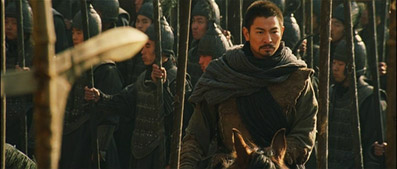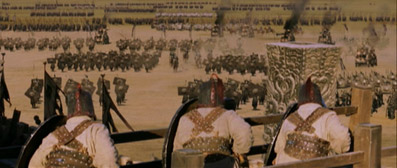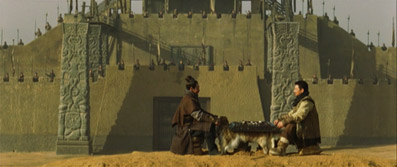|
Battle of Wits is set in 370 BC, a period in which China was divided into several warring states vying for control of the country. The unification of these states was notably mythologized in Zhang Yimou's Hero; Battle of Wits [Muk gong] plays fast and loose with history in a similar manner. The battle occurs in the fictional city of Liang, the last outpost between the province of Yu and the invading armies of the Zhao nation. With the Zhao forces at the gates, the Prince of Liang (Siwon Choi) petitions for help from Mozi General Ge Li (Andy Lau), who arrives alone to galvanize the city's forces and repel the invaders.
Although marketing material will happily namedrop Hero, Crouching Tiger Hidden Dragon or House of Flying Daggers as contemporaries, Battle of Wits is a more grounded affair, playing out for the most part as a classic siege film. The traditional pleasures of the siege film are in watching the main characters formulate ingenious methods of repelling the invaders, and then witnessing the astonishment of the soldiers as the often-bizarre strategies succeed. Battle of Wits gives us all of this; the laying out of a strategy, building defenses, some rousing speeches by Ge Li, a sortie behind enemy lines and some lessons in putting class differences aside and working together for a common good. The formula works for the most part, although a desire to differentiate the battle scenes from other siege films often results in some odd moments, such as when Ge Li orders the peasants to build a defensive wall perfectly in line with the main city wall ('the efficiency of the Liang people will intimidate our enemies!') or have all of the house roofs in the city smeared with excrement in order to douse incoming fire arrows.

That aside, most of the film follows the siege pattern rather closely, before a plot twist at the end of the second act. The film also finds room for some sombre moments which make a welcome break from the action. Although all dressed in black and with vastly superior numbers, the Zhao forces aren't written completely malevolently and the enemy commander Xiao is given plenty of room for empathy. Likewise the film weaves in smaller moments that undercut some of the grandiose battle scenes and blur the lines between the opposing sides; the Liang defenders ruthlessly massacre some Zhao prisoners of war, an escaped Zhao slave is hounded by a city mob, the peasants living in the city are portrayed as treacherous victims who are as much abused by their protectors as they are by the enemy. Although the film valiantly augments the plot with some reflective anti-war sentiment, its attempts to flesh out some of the characters come across as half-hearted. There are some admirable efforts, such as a Liang soldier who defies rank and becomes leader of the city archers, or the Prince of Liang who struggles with his status and ability, but for the most part the characterization is secondary to the concerns of the plot; worth noting that the film's only prominent female role, cavalry officer Yi Yue is largely perfunctory.
The screenplay invests heavily in its protagonist, and Andy Lau as Ge Li doesn't disappoint. As the man who holds the cards for the majority of the action Ge Li is a naturally enigmatic presence, formulating strategies of defense, standing a few rungs above everyone else on the moral ladder and even finding time for some swashbuckling feats of derring-do, including a rope jump over a raising drawbridge straight from the Douglas Fairbanks textbook. Ge Li is undoubtedly a modern man; he sports close cropped hair and a perfectly clipped beard, striding into the film wearing a mystic-style robe and then sporting long jackets and even a scarf. Lau is on top form; he gives the role all of his inherent swagger and tight, considered movement, stealing most of the scenes in the process. Some other notable performances include the Zhao commander, played with dignified pride by Ahn Sung-Kee and Si Won Choi, who impresses, even if his character Prince Liang Shi is rather marginalized.

Director Jacob Cheung keeps a tight control over proceedings, given that epics and in particularly siege stories can often be unwieldy and confusing. The job is made more difficult by the colour scheme. The dull browns and greys of the desert aren't much to look at and the heavy use of the same colours for costuming and set design can make for a straining experience. Although it is useful to have the Zhao dressed in black and the Liang dressed in tan/red in order to differentiate, the similarity of the costumes and low-lighting on the night scenes means that very often it is difficult to follow the progression on some of the action sequences. Cheung compensates for this by using his space very effectively. Battle scenes commonly begin close up to a single object and then move outwards, gradually revealing the locations and positions of all the key elements of the scene. Cheung also has an eye for depth, often organizing his frames with 3 planes of action, making full use of the background, middleground and foreground to make the piece feel as large-scale as possible. The size of the battleground is very well rendered, and when Xiao and Ge Li play chess against the backdrop of the castle the sense of scale is palpable. Similarly for the scenes inside the castle the frames are as tightly packed as possible, filling the frames with extras and set details. Not only does this show off the impressive Liang set, but it also gives a rather claustrophobic feel, reflecting the tightly-packed conditions of the characters. Cheung also pushes main characters to the sides of the frame to emphasize the film's communal viewpoint. Although this rather successfully gives an idea of a community rallying together in enclosed conditions, the preference for long and mid-shots (to fit everything in) does little to salve the film's characterization problems. There are very few close-ups, making it even harder to engage with characters who are already a little too thin. That said, the scenery and action that is favoured is very impressive; the action is choreographed in an exciting way and Cheung's careful direction manages the larger set-pieces with suitable economy. There are all the classic siege elements at play; hails of arrows, soldiers being pushed from parapets, cavalry charges and a standout moment where Zhao forces raid the city by hot air balloon.
The anamorphic 2.35:1 transfer is very good but just a shade or two shy of the sort of pin-sharp transfers that Hero and House of Flying Daggers received. The golden tint to daylight scenes is clearly intentional and cleanly reproduced, as is the bluer look of night scenes. The contrast and detail are good, although the former is not quite as punchy on the darker sequences. A good transfer that nonetheless doesn't pop out of the screen at any point. It would be interesting to see how the simultaneously released Blu-ray disc looks by comparison.

The soundtrack options offer a choice between Dolby 2.0 stereo and Dolby 5.1 surround. Both are clear and full bodied, particularly in the reproduction of music and activity, with clear seperation of effects on both. The surround track is inevitably more inclusive and boasts some solid (though not excessive) bass on the big drums in the score.
The English subtitles are optional.
The international trailer (2:12) is honest and involving, whereas the UK trailer (1:00) feels cobbled together in a couple of minutes, showing random clips from the battle scenes cut with over the top intertitles. A very good 'Making Of' (50:54) intercuts interviews with Andy Lau and Jacob Cheung with footage of the film being made, and the feature goes into a lot of detail about the effects used in certain sequences. There is also a lot of footage of the film actually being shot, which is enjoyable if a little disjointed.
Overall the film is an enjoyable epic, and the attempt to inject some pathos into a largely mythological genre film is very welcome. Despite some mixed characterization and stylistic choices the film is worth picking up for its impressive battle sequences and assured treatment of the subject matter.
|